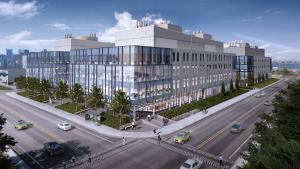3 Things Owners Can Do (Right Now) to Protect Buildings from Climate Change
Here’s a mind-blowing statistic: by 2070, the number of 90-100 degree days in Boston will go from 25 to 90 with up to 33 days above 100 degrees.
It’s a startling fact as it will change our daily lives in many ways, including how we construct new buildings and protect existing ones. And, if you’ve started a building project over 50,000 square feet in Boston recently, this statistic should not be new to you since it is stated in Boston’s Climate Resiliency Checklist Report, which is required as part of the large project review process.
 But, does the Climate Resiliency Report go far enough? The answer is generally “yes”. While you will want a design and construction team to provide insights into what resiliency measures are significant for your assets and what the associated costs are, the Resiliency Report highlights the key areas owners need to be looking at. It forces owners to evaluate their design strategies for dealing with extreme heat, extreme precipitation, and sea level rise while providing context for why these items are locally significant.
But, does the Climate Resiliency Report go far enough? The answer is generally “yes”. While you will want a design and construction team to provide insights into what resiliency measures are significant for your assets and what the associated costs are, the Resiliency Report highlights the key areas owners need to be looking at. It forces owners to evaluate their design strategies for dealing with extreme heat, extreme precipitation, and sea level rise while providing context for why these items are locally significant.
Although filling out the Resiliency Report is required for large projects, there are no regulations for the enforcement of any resiliency measures in practice. However, many smart building owners are implementing measures now to protect property as heat, flooding, and wind become greater threats.
While 2070 may seem like eons from now, the Greater Boston region is already feeling the effects of climate change. In June, three school districts and one regional high school closed due to extreme heat. In March, Bostonians watched in disbelief as a Nor’easter flooded the Seaport. The Governor declared a state of emergency and the New England Aquarium was forced to close for two days.
Cautious insurers are requiring building owners to make adjustments to their buildings or risk losing coverage or seeing premiums increase. According to the World Bank, Boston is the eighth most vulnerable city in the world in regard to the overall cost of damage as a result of storm surges and flooding. And by 2030 there will be 4 to 8 inches of sea level rise (above Boston Harbor levels in 2000) and 7 inches to 1.5 feet by 2050, according to the Boston Research Advisory Group.

While climate seems out of our control, there are things that building owners and developers of new construction can do now to lessen the damage. One strategy we are seeing evaluated at flood-risk properties in the Seaport is the use of fencing systems – some temporary, some permanent – to keep water out during flood events. We can help owners look at the cost of materials, system effectiveness, the time it takes to mobilize the system in advance of an event, and the cost of man-hours to put the system in place and take it out.
One of the more popular temporary fence systems – AquaFence – costs a comparable amount for materials as sandbags ($300 to $500 per linear foot), and can provide very effective protection against flood water infiltration. When factoring in installation and breakdown time, the AquaFence is actually a cheaper option.
These fence systems were built into the design at Innovation Square in Boston’s Seaport District, where we are building a 360,000-square-foot, state-of-the-art life science building.
So how do you get to the point of knowing what you need? Here are three things that owners can do now:
 Identify the top three areas of vulnerability and related levels of risk. The Boston Climate Resiliency Checklist Report and the Climate Ready Boston Map Explorer are great resources.
Identify the top three areas of vulnerability and related levels of risk. The Boston Climate Resiliency Checklist Report and the Climate Ready Boston Map Explorer are great resources.
 Consider temporary or permanent fencing systems. A popular fence system, AquaFence, can provide effective protection against flood water infiltration.
Consider temporary or permanent fencing systems. A popular fence system, AquaFence, can provide effective protection against flood water infiltration.
 Consult with designers and builders to create an action plan for closing the gaps between risk exposures and level of preparedness. See how Consigli is doing this on the new GE Headquarters in Boston.
Consult with designers and builders to create an action plan for closing the gaps between risk exposures and level of preparedness. See how Consigli is doing this on the new GE Headquarters in Boston.
Want to know more? Connect with our team.
Brian Barringer BarringerDirector of Commercial Development t: 617.502.1836 e: bbarringer@consigli.com |
|
Steven Burke, LEED & WELL Faculty Burke, LEED & WELL FacultySustainability Manager t: 774.462.2044 e: sburke@consigli.com |
